History and Theory of Architecture: Postmodernism and Housing
VerifiedAdded on 2023/01/12
|12
|4010
|39
Essay
AI Summary
This essay delves into the history and theory of postmodern architecture and housing, providing a comprehensive overview of the subject. It begins by defining postmodernism in architecture, contrasting it with modernism and exploring the rejection of traditional styles. The essay examines the historical context of postmodernism, its key figures like Le Corbusier and Michael Graves, and the debates surrounding its principles. It then explores the evolution of housing styles, from detached houses to apartments, and the impact of technological advancements and population growth on housing design. The essay also integrates architectural, social, and housing history, examining how housing transformations reflect broader demographic and socioeconomic changes. It considers the impact of urban planning and political interventions on construction techniques, and the development of housing throughout history.
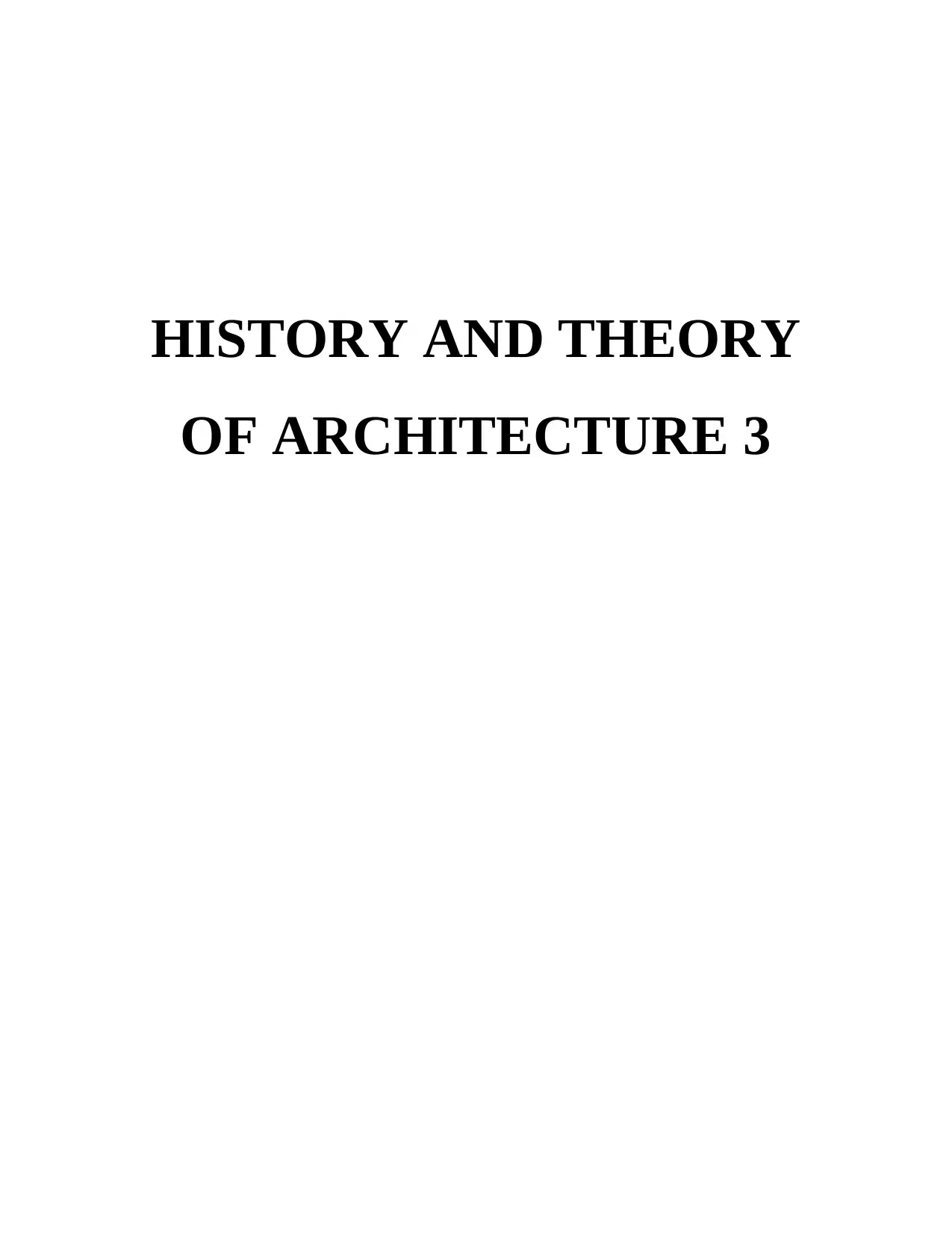
HISTORY AND THEORY
OF ARCHITECTURE 3
OF ARCHITECTURE 3
Paraphrase This Document
Need a fresh take? Get an instant paraphrase of this document with our AI Paraphraser
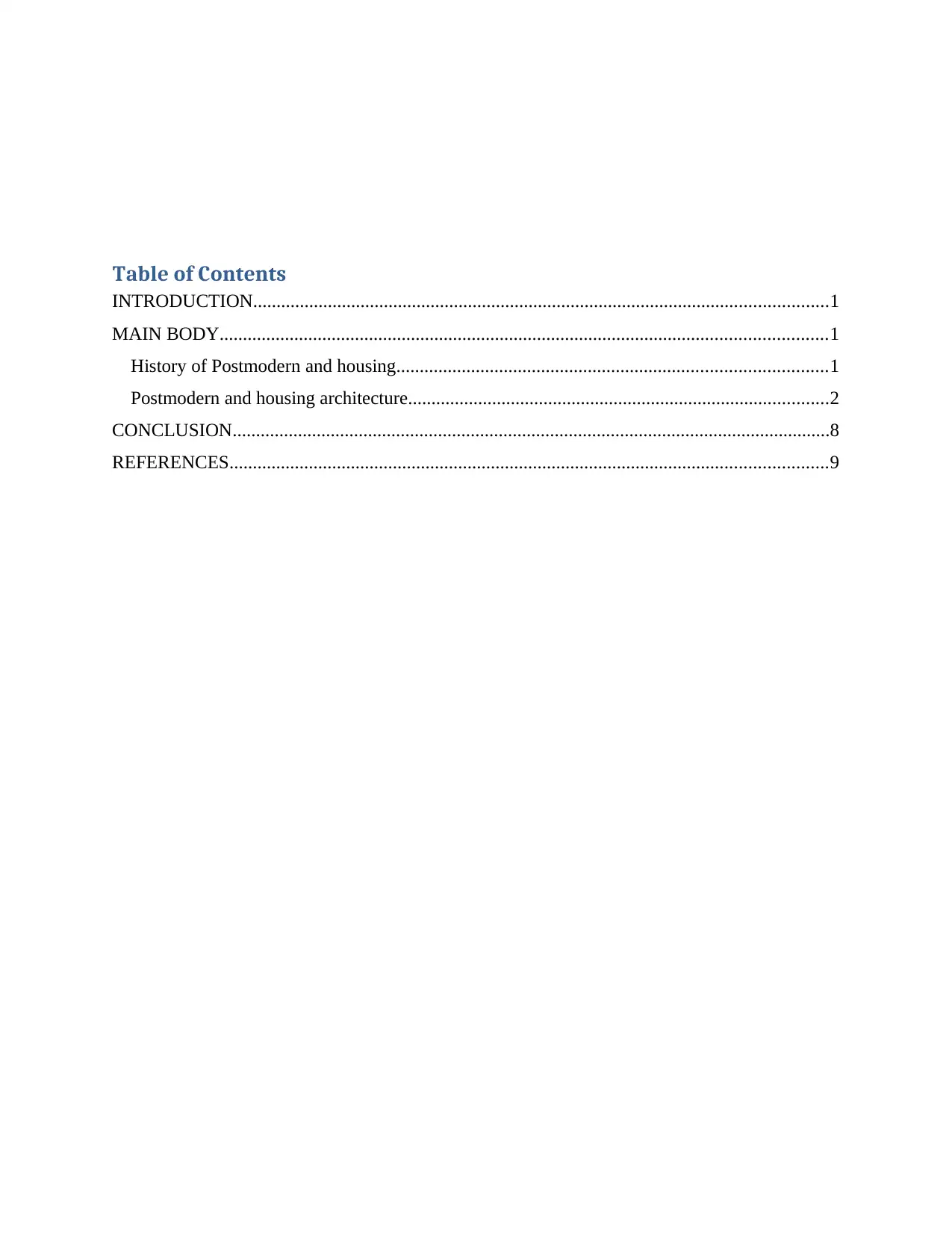
Table of Contents
INTRODUCTION...........................................................................................................................1
MAIN BODY..................................................................................................................................1
History of Postmodern and housing............................................................................................1
Postmodern and housing architecture..........................................................................................2
CONCLUSION................................................................................................................................8
REFERENCES................................................................................................................................9
INTRODUCTION...........................................................................................................................1
MAIN BODY..................................................................................................................................1
History of Postmodern and housing............................................................................................1
Postmodern and housing architecture..........................................................................................2
CONCLUSION................................................................................................................................8
REFERENCES................................................................................................................................9
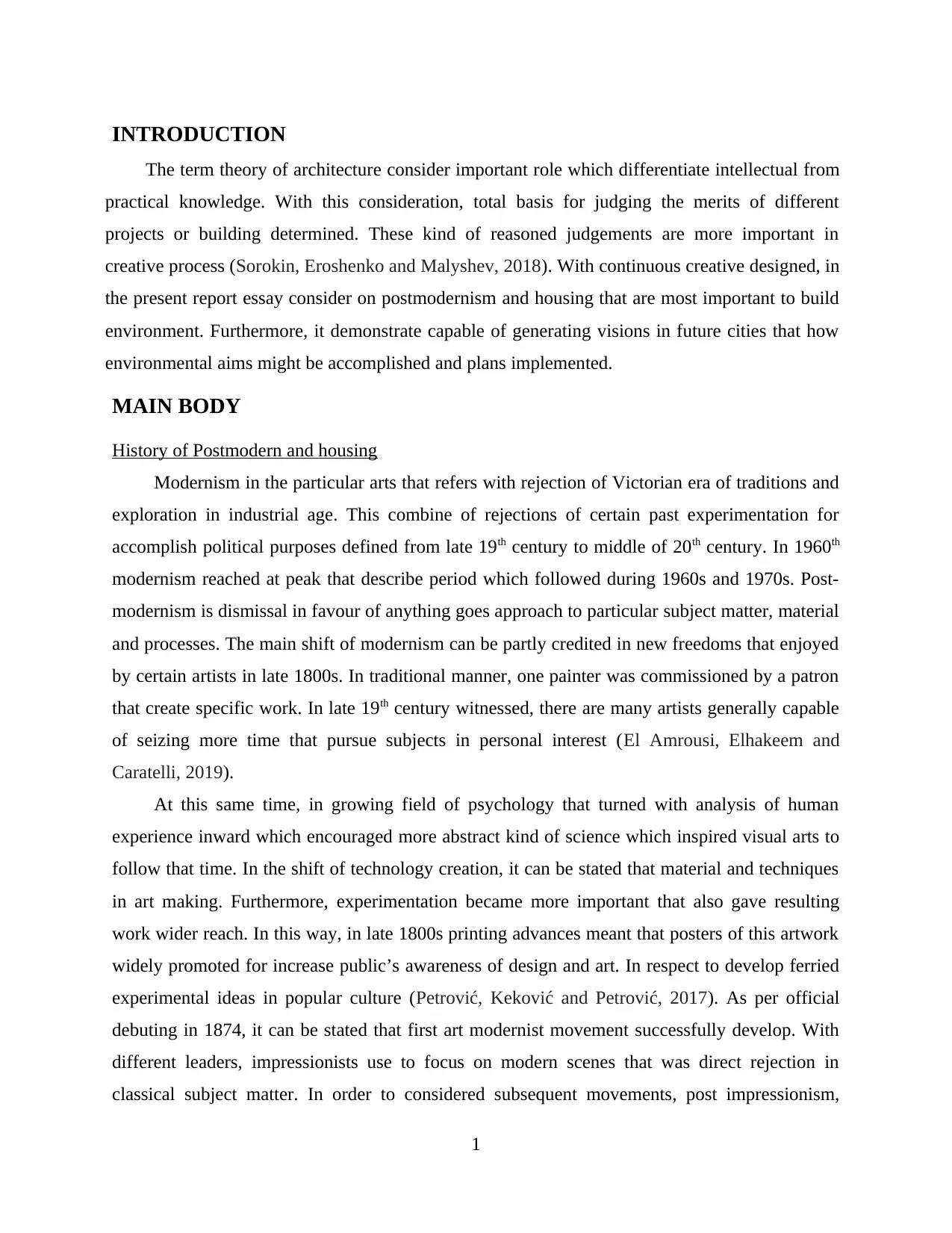
INTRODUCTION
The term theory of architecture consider important role which differentiate intellectual from
practical knowledge. With this consideration, total basis for judging the merits of different
projects or building determined. These kind of reasoned judgements are more important in
creative process (Sorokin, Eroshenko and Malyshev, 2018). With continuous creative designed, in
the present report essay consider on postmodernism and housing that are most important to build
environment. Furthermore, it demonstrate capable of generating visions in future cities that how
environmental aims might be accomplished and plans implemented.
MAIN BODY
History of Postmodern and housing
Modernism in the particular arts that refers with rejection of Victorian era of traditions and
exploration in industrial age. This combine of rejections of certain past experimentation for
accomplish political purposes defined from late 19th century to middle of 20th century. In 1960th
modernism reached at peak that describe period which followed during 1960s and 1970s. Post-
modernism is dismissal in favour of anything goes approach to particular subject matter, material
and processes. The main shift of modernism can be partly credited in new freedoms that enjoyed
by certain artists in late 1800s. In traditional manner, one painter was commissioned by a patron
that create specific work. In late 19th century witnessed, there are many artists generally capable
of seizing more time that pursue subjects in personal interest (El Amrousi, Elhakeem and
Caratelli, 2019).
At this same time, in growing field of psychology that turned with analysis of human
experience inward which encouraged more abstract kind of science which inspired visual arts to
follow that time. In the shift of technology creation, it can be stated that material and techniques
in art making. Furthermore, experimentation became more important that also gave resulting
work wider reach. In this way, in late 1800s printing advances meant that posters of this artwork
widely promoted for increase public’s awareness of design and art. In respect to develop ferried
experimental ideas in popular culture (Petrović, Keković and Petrović, 2017). As per official
debuting in 1874, it can be stated that first art modernist movement successfully develop. With
different leaders, impressionists use to focus on modern scenes that was direct rejection in
classical subject matter. In order to considered subsequent movements, post impressionism,
1
The term theory of architecture consider important role which differentiate intellectual from
practical knowledge. With this consideration, total basis for judging the merits of different
projects or building determined. These kind of reasoned judgements are more important in
creative process (Sorokin, Eroshenko and Malyshev, 2018). With continuous creative designed, in
the present report essay consider on postmodernism and housing that are most important to build
environment. Furthermore, it demonstrate capable of generating visions in future cities that how
environmental aims might be accomplished and plans implemented.
MAIN BODY
History of Postmodern and housing
Modernism in the particular arts that refers with rejection of Victorian era of traditions and
exploration in industrial age. This combine of rejections of certain past experimentation for
accomplish political purposes defined from late 19th century to middle of 20th century. In 1960th
modernism reached at peak that describe period which followed during 1960s and 1970s. Post-
modernism is dismissal in favour of anything goes approach to particular subject matter, material
and processes. The main shift of modernism can be partly credited in new freedoms that enjoyed
by certain artists in late 1800s. In traditional manner, one painter was commissioned by a patron
that create specific work. In late 19th century witnessed, there are many artists generally capable
of seizing more time that pursue subjects in personal interest (El Amrousi, Elhakeem and
Caratelli, 2019).
At this same time, in growing field of psychology that turned with analysis of human
experience inward which encouraged more abstract kind of science which inspired visual arts to
follow that time. In the shift of technology creation, it can be stated that material and techniques
in art making. Furthermore, experimentation became more important that also gave resulting
work wider reach. In this way, in late 1800s printing advances meant that posters of this artwork
widely promoted for increase public’s awareness of design and art. In respect to develop ferried
experimental ideas in popular culture (Petrović, Keković and Petrović, 2017). As per official
debuting in 1874, it can be stated that first art modernist movement successfully develop. With
different leaders, impressionists use to focus on modern scenes that was direct rejection in
classical subject matter. In order to considered subsequent movements, post impressionism,
1
⊘ This is a preview!⊘
Do you want full access?
Subscribe today to unlock all pages.

Trusted by 1+ million students worldwide
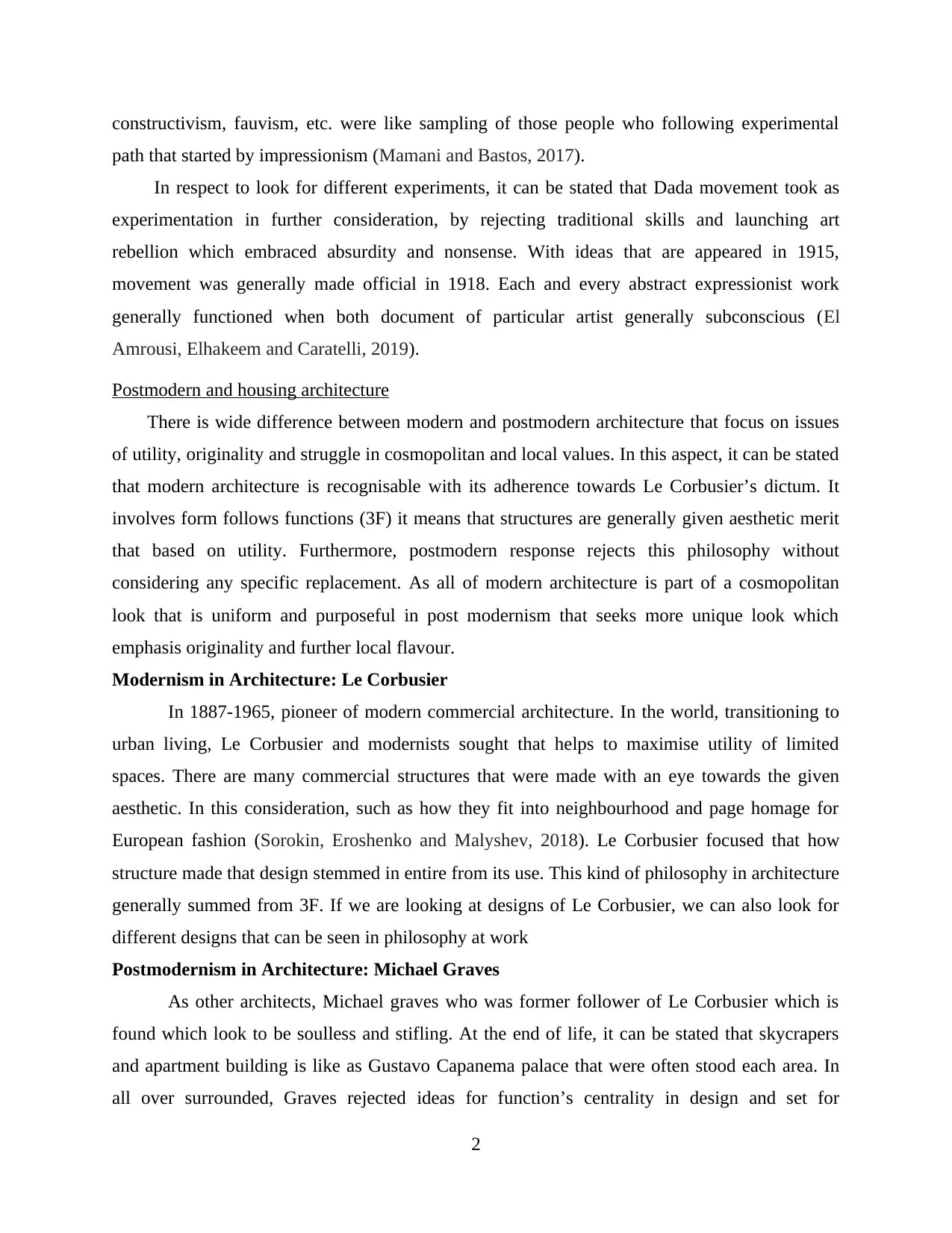
constructivism, fauvism, etc. were like sampling of those people who following experimental
path that started by impressionism (Mamani and Bastos, 2017).
In respect to look for different experiments, it can be stated that Dada movement took as
experimentation in further consideration, by rejecting traditional skills and launching art
rebellion which embraced absurdity and nonsense. With ideas that are appeared in 1915,
movement was generally made official in 1918. Each and every abstract expressionist work
generally functioned when both document of particular artist generally subconscious (El
Amrousi, Elhakeem and Caratelli, 2019).
Postmodern and housing architecture
There is wide difference between modern and postmodern architecture that focus on issues
of utility, originality and struggle in cosmopolitan and local values. In this aspect, it can be stated
that modern architecture is recognisable with its adherence towards Le Corbusier’s dictum. It
involves form follows functions (3F) it means that structures are generally given aesthetic merit
that based on utility. Furthermore, postmodern response rejects this philosophy without
considering any specific replacement. As all of modern architecture is part of a cosmopolitan
look that is uniform and purposeful in post modernism that seeks more unique look which
emphasis originality and further local flavour.
Modernism in Architecture: Le Corbusier
In 1887-1965, pioneer of modern commercial architecture. In the world, transitioning to
urban living, Le Corbusier and modernists sought that helps to maximise utility of limited
spaces. There are many commercial structures that were made with an eye towards the given
aesthetic. In this consideration, such as how they fit into neighbourhood and page homage for
European fashion (Sorokin, Eroshenko and Malyshev, 2018). Le Corbusier focused that how
structure made that design stemmed in entire from its use. This kind of philosophy in architecture
generally summed from 3F. If we are looking at designs of Le Corbusier, we can also look for
different designs that can be seen in philosophy at work
Postmodernism in Architecture: Michael Graves
As other architects, Michael graves who was former follower of Le Corbusier which is
found which look to be soulless and stifling. At the end of life, it can be stated that skycrapers
and apartment building is like as Gustavo Capanema palace that were often stood each area. In
all over surrounded, Graves rejected ideas for function’s centrality in design and set for
2
path that started by impressionism (Mamani and Bastos, 2017).
In respect to look for different experiments, it can be stated that Dada movement took as
experimentation in further consideration, by rejecting traditional skills and launching art
rebellion which embraced absurdity and nonsense. With ideas that are appeared in 1915,
movement was generally made official in 1918. Each and every abstract expressionist work
generally functioned when both document of particular artist generally subconscious (El
Amrousi, Elhakeem and Caratelli, 2019).
Postmodern and housing architecture
There is wide difference between modern and postmodern architecture that focus on issues
of utility, originality and struggle in cosmopolitan and local values. In this aspect, it can be stated
that modern architecture is recognisable with its adherence towards Le Corbusier’s dictum. It
involves form follows functions (3F) it means that structures are generally given aesthetic merit
that based on utility. Furthermore, postmodern response rejects this philosophy without
considering any specific replacement. As all of modern architecture is part of a cosmopolitan
look that is uniform and purposeful in post modernism that seeks more unique look which
emphasis originality and further local flavour.
Modernism in Architecture: Le Corbusier
In 1887-1965, pioneer of modern commercial architecture. In the world, transitioning to
urban living, Le Corbusier and modernists sought that helps to maximise utility of limited
spaces. There are many commercial structures that were made with an eye towards the given
aesthetic. In this consideration, such as how they fit into neighbourhood and page homage for
European fashion (Sorokin, Eroshenko and Malyshev, 2018). Le Corbusier focused that how
structure made that design stemmed in entire from its use. This kind of philosophy in architecture
generally summed from 3F. If we are looking at designs of Le Corbusier, we can also look for
different designs that can be seen in philosophy at work
Postmodernism in Architecture: Michael Graves
As other architects, Michael graves who was former follower of Le Corbusier which is
found which look to be soulless and stifling. At the end of life, it can be stated that skycrapers
and apartment building is like as Gustavo Capanema palace that were often stood each area. In
all over surrounded, Graves rejected ideas for function’s centrality in design and set for
2
Paraphrase This Document
Need a fresh take? Get an instant paraphrase of this document with our AI Paraphraser
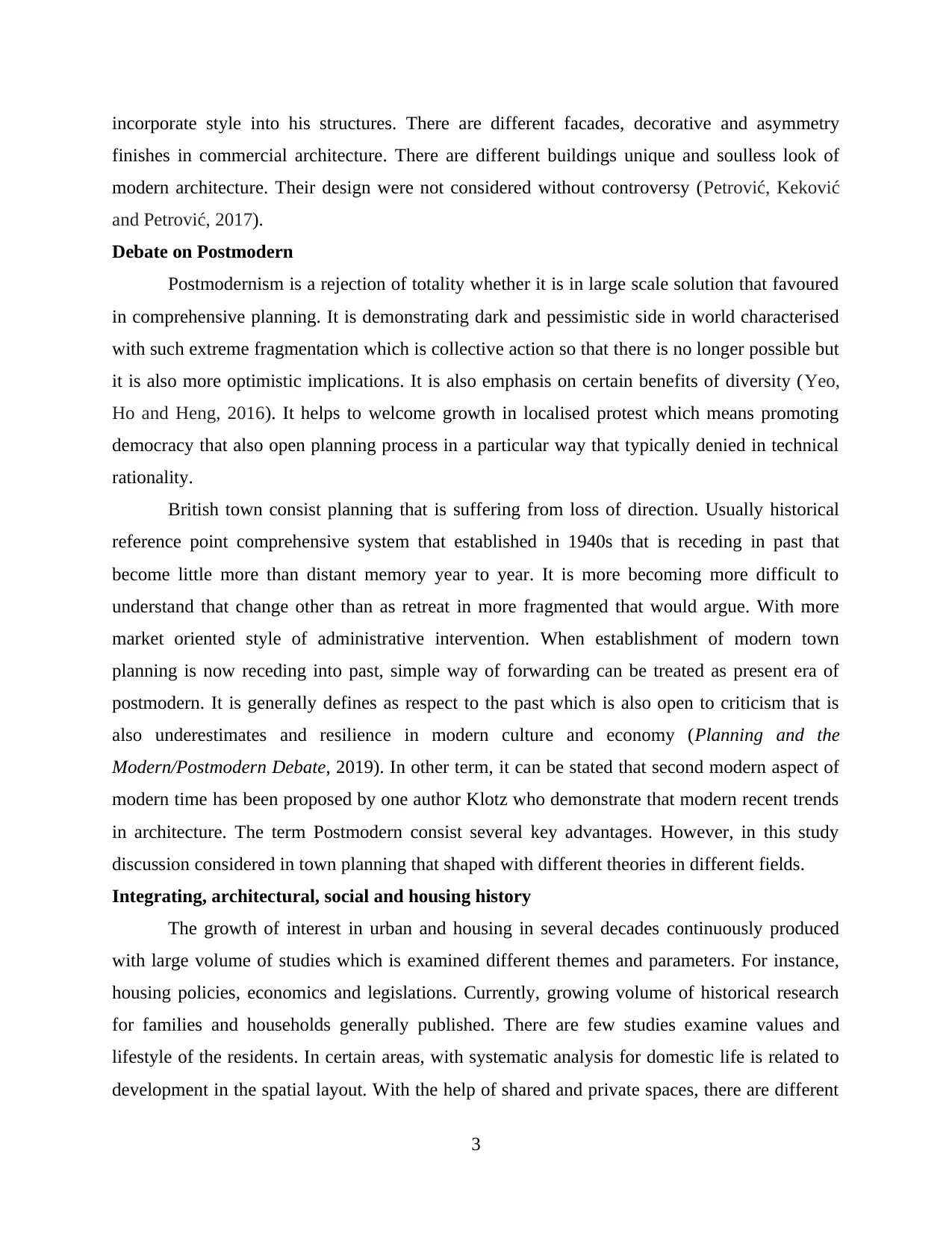
incorporate style into his structures. There are different facades, decorative and asymmetry
finishes in commercial architecture. There are different buildings unique and soulless look of
modern architecture. Their design were not considered without controversy (Petrović, Keković
and Petrović, 2017).
Debate on Postmodern
Postmodernism is a rejection of totality whether it is in large scale solution that favoured
in comprehensive planning. It is demonstrating dark and pessimistic side in world characterised
with such extreme fragmentation which is collective action so that there is no longer possible but
it is also more optimistic implications. It is also emphasis on certain benefits of diversity (Yeo,
Ho and Heng, 2016). It helps to welcome growth in localised protest which means promoting
democracy that also open planning process in a particular way that typically denied in technical
rationality.
British town consist planning that is suffering from loss of direction. Usually historical
reference point comprehensive system that established in 1940s that is receding in past that
become little more than distant memory year to year. It is more becoming more difficult to
understand that change other than as retreat in more fragmented that would argue. With more
market oriented style of administrative intervention. When establishment of modern town
planning is now receding into past, simple way of forwarding can be treated as present era of
postmodern. It is generally defines as respect to the past which is also open to criticism that is
also underestimates and resilience in modern culture and economy (Planning and the
Modern/Postmodern Debate, 2019). In other term, it can be stated that second modern aspect of
modern time has been proposed by one author Klotz who demonstrate that modern recent trends
in architecture. The term Postmodern consist several key advantages. However, in this study
discussion considered in town planning that shaped with different theories in different fields.
Integrating, architectural, social and housing history
The growth of interest in urban and housing in several decades continuously produced
with large volume of studies which is examined different themes and parameters. For instance,
housing policies, economics and legislations. Currently, growing volume of historical research
for families and households generally published. There are few studies examine values and
lifestyle of the residents. In certain areas, with systematic analysis for domestic life is related to
development in the spatial layout. With the help of shared and private spaces, there are different
3
finishes in commercial architecture. There are different buildings unique and soulless look of
modern architecture. Their design were not considered without controversy (Petrović, Keković
and Petrović, 2017).
Debate on Postmodern
Postmodernism is a rejection of totality whether it is in large scale solution that favoured
in comprehensive planning. It is demonstrating dark and pessimistic side in world characterised
with such extreme fragmentation which is collective action so that there is no longer possible but
it is also more optimistic implications. It is also emphasis on certain benefits of diversity (Yeo,
Ho and Heng, 2016). It helps to welcome growth in localised protest which means promoting
democracy that also open planning process in a particular way that typically denied in technical
rationality.
British town consist planning that is suffering from loss of direction. Usually historical
reference point comprehensive system that established in 1940s that is receding in past that
become little more than distant memory year to year. It is more becoming more difficult to
understand that change other than as retreat in more fragmented that would argue. With more
market oriented style of administrative intervention. When establishment of modern town
planning is now receding into past, simple way of forwarding can be treated as present era of
postmodern. It is generally defines as respect to the past which is also open to criticism that is
also underestimates and resilience in modern culture and economy (Planning and the
Modern/Postmodern Debate, 2019). In other term, it can be stated that second modern aspect of
modern time has been proposed by one author Klotz who demonstrate that modern recent trends
in architecture. The term Postmodern consist several key advantages. However, in this study
discussion considered in town planning that shaped with different theories in different fields.
Integrating, architectural, social and housing history
The growth of interest in urban and housing in several decades continuously produced
with large volume of studies which is examined different themes and parameters. For instance,
housing policies, economics and legislations. Currently, growing volume of historical research
for families and households generally published. There are few studies examine values and
lifestyle of the residents. In certain areas, with systematic analysis for domestic life is related to
development in the spatial layout. With the help of shared and private spaces, there are different
3
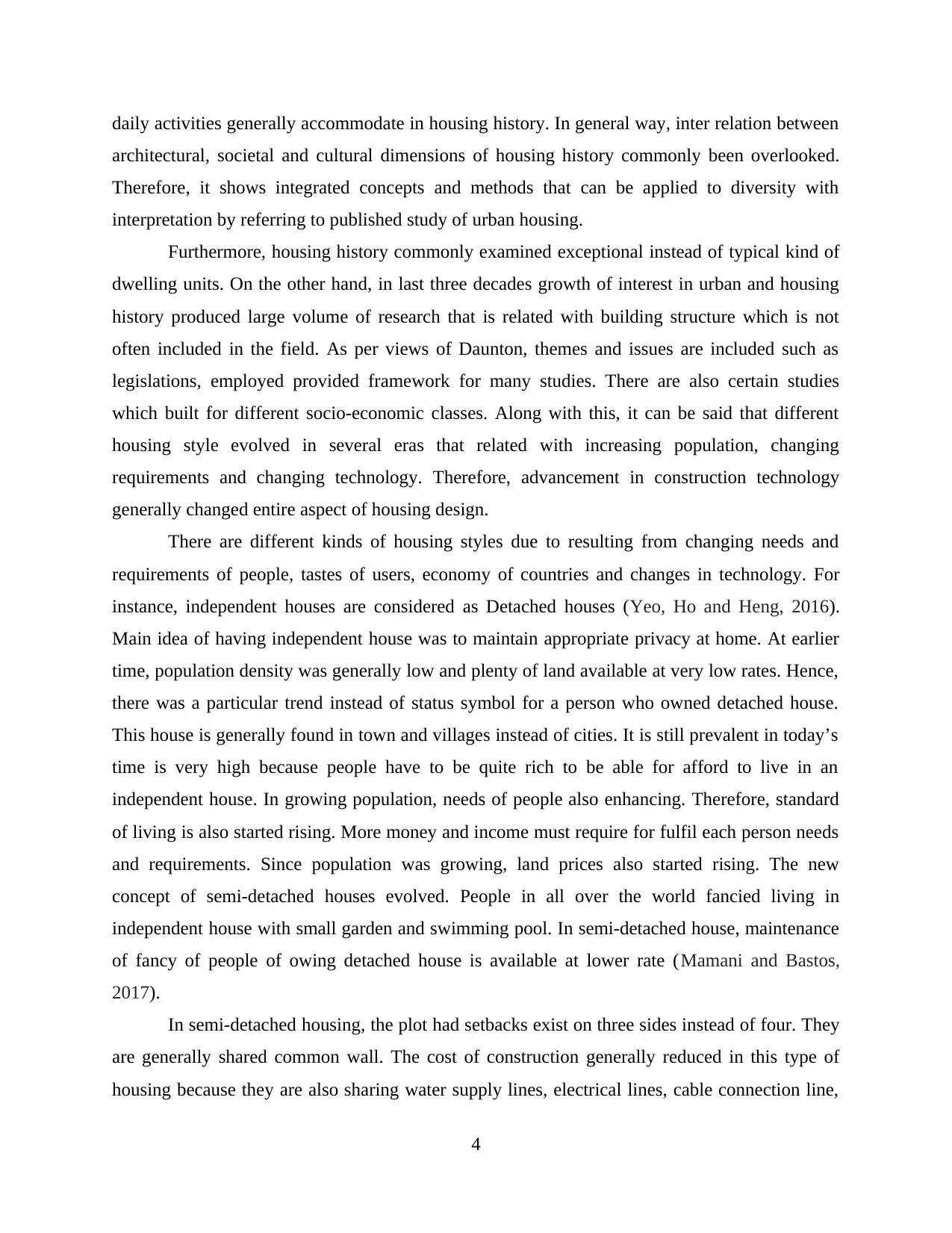
daily activities generally accommodate in housing history. In general way, inter relation between
architectural, societal and cultural dimensions of housing history commonly been overlooked.
Therefore, it shows integrated concepts and methods that can be applied to diversity with
interpretation by referring to published study of urban housing.
Furthermore, housing history commonly examined exceptional instead of typical kind of
dwelling units. On the other hand, in last three decades growth of interest in urban and housing
history produced large volume of research that is related with building structure which is not
often included in the field. As per views of Daunton, themes and issues are included such as
legislations, employed provided framework for many studies. There are also certain studies
which built for different socio-economic classes. Along with this, it can be said that different
housing style evolved in several eras that related with increasing population, changing
requirements and changing technology. Therefore, advancement in construction technology
generally changed entire aspect of housing design.
There are different kinds of housing styles due to resulting from changing needs and
requirements of people, tastes of users, economy of countries and changes in technology. For
instance, independent houses are considered as Detached houses (Yeo, Ho and Heng, 2016).
Main idea of having independent house was to maintain appropriate privacy at home. At earlier
time, population density was generally low and plenty of land available at very low rates. Hence,
there was a particular trend instead of status symbol for a person who owned detached house.
This house is generally found in town and villages instead of cities. It is still prevalent in today’s
time is very high because people have to be quite rich to be able for afford to live in an
independent house. In growing population, needs of people also enhancing. Therefore, standard
of living is also started rising. More money and income must require for fulfil each person needs
and requirements. Since population was growing, land prices also started rising. The new
concept of semi-detached houses evolved. People in all over the world fancied living in
independent house with small garden and swimming pool. In semi-detached house, maintenance
of fancy of people of owing detached house is available at lower rate (Mamani and Bastos,
2017).
In semi-detached housing, the plot had setbacks exist on three sides instead of four. They
are generally shared common wall. The cost of construction generally reduced in this type of
housing because they are also sharing water supply lines, electrical lines, cable connection line,
4
architectural, societal and cultural dimensions of housing history commonly been overlooked.
Therefore, it shows integrated concepts and methods that can be applied to diversity with
interpretation by referring to published study of urban housing.
Furthermore, housing history commonly examined exceptional instead of typical kind of
dwelling units. On the other hand, in last three decades growth of interest in urban and housing
history produced large volume of research that is related with building structure which is not
often included in the field. As per views of Daunton, themes and issues are included such as
legislations, employed provided framework for many studies. There are also certain studies
which built for different socio-economic classes. Along with this, it can be said that different
housing style evolved in several eras that related with increasing population, changing
requirements and changing technology. Therefore, advancement in construction technology
generally changed entire aspect of housing design.
There are different kinds of housing styles due to resulting from changing needs and
requirements of people, tastes of users, economy of countries and changes in technology. For
instance, independent houses are considered as Detached houses (Yeo, Ho and Heng, 2016).
Main idea of having independent house was to maintain appropriate privacy at home. At earlier
time, population density was generally low and plenty of land available at very low rates. Hence,
there was a particular trend instead of status symbol for a person who owned detached house.
This house is generally found in town and villages instead of cities. It is still prevalent in today’s
time is very high because people have to be quite rich to be able for afford to live in an
independent house. In growing population, needs of people also enhancing. Therefore, standard
of living is also started rising. More money and income must require for fulfil each person needs
and requirements. Since population was growing, land prices also started rising. The new
concept of semi-detached houses evolved. People in all over the world fancied living in
independent house with small garden and swimming pool. In semi-detached house, maintenance
of fancy of people of owing detached house is available at lower rate (Mamani and Bastos,
2017).
In semi-detached housing, the plot had setbacks exist on three sides instead of four. They
are generally shared common wall. The cost of construction generally reduced in this type of
housing because they are also sharing water supply lines, electrical lines, cable connection line,
4
⊘ This is a preview!⊘
Do you want full access?
Subscribe today to unlock all pages.

Trusted by 1+ million students worldwide
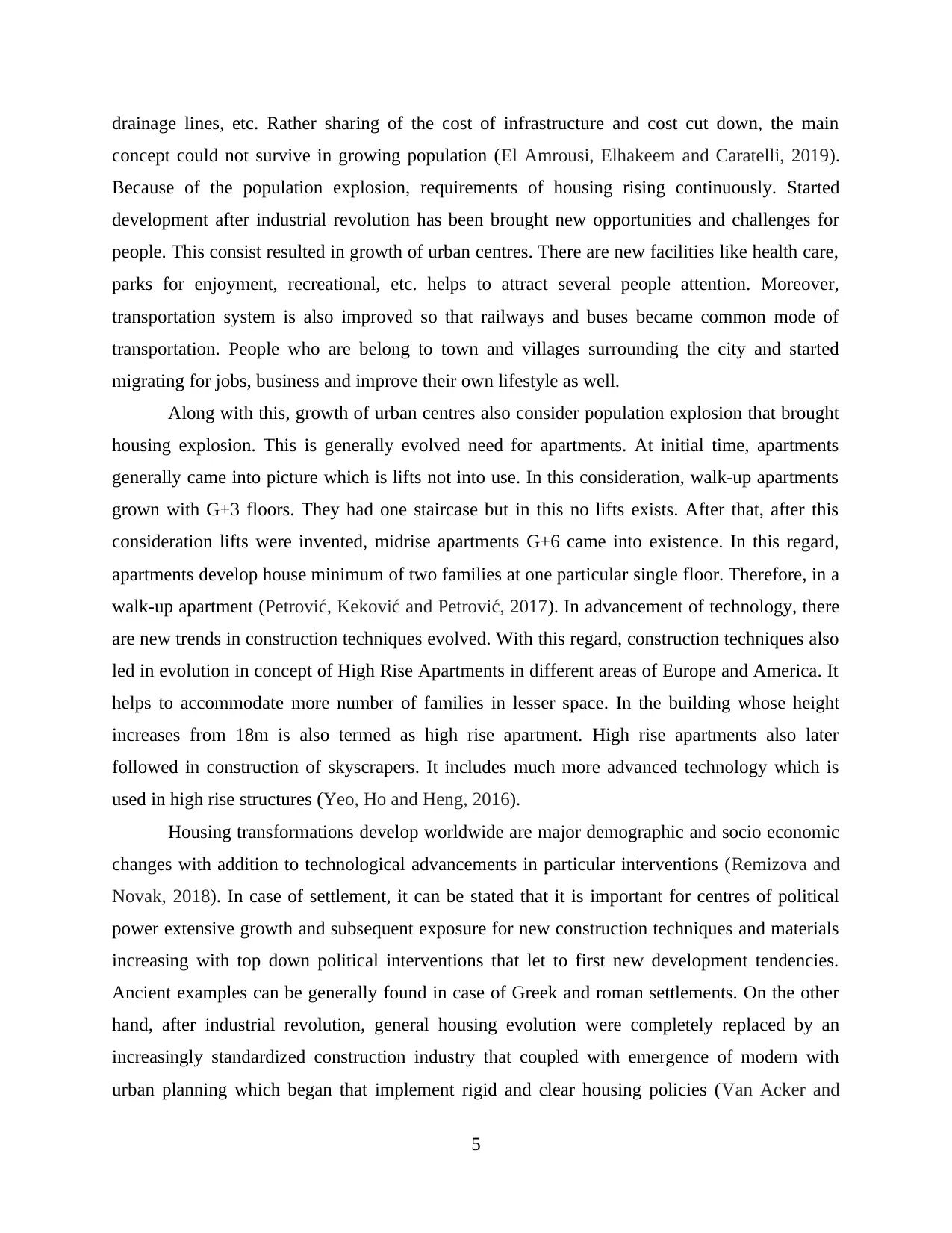
drainage lines, etc. Rather sharing of the cost of infrastructure and cost cut down, the main
concept could not survive in growing population (El Amrousi, Elhakeem and Caratelli, 2019).
Because of the population explosion, requirements of housing rising continuously. Started
development after industrial revolution has been brought new opportunities and challenges for
people. This consist resulted in growth of urban centres. There are new facilities like health care,
parks for enjoyment, recreational, etc. helps to attract several people attention. Moreover,
transportation system is also improved so that railways and buses became common mode of
transportation. People who are belong to town and villages surrounding the city and started
migrating for jobs, business and improve their own lifestyle as well.
Along with this, growth of urban centres also consider population explosion that brought
housing explosion. This is generally evolved need for apartments. At initial time, apartments
generally came into picture which is lifts not into use. In this consideration, walk-up apartments
grown with G+3 floors. They had one staircase but in this no lifts exists. After that, after this
consideration lifts were invented, midrise apartments G+6 came into existence. In this regard,
apartments develop house minimum of two families at one particular single floor. Therefore, in a
walk-up apartment (Petrović, Keković and Petrović, 2017). In advancement of technology, there
are new trends in construction techniques evolved. With this regard, construction techniques also
led in evolution in concept of High Rise Apartments in different areas of Europe and America. It
helps to accommodate more number of families in lesser space. In the building whose height
increases from 18m is also termed as high rise apartment. High rise apartments also later
followed in construction of skyscrapers. It includes much more advanced technology which is
used in high rise structures (Yeo, Ho and Heng, 2016).
Housing transformations develop worldwide are major demographic and socio economic
changes with addition to technological advancements in particular interventions (Remizova and
Novak, 2018). In case of settlement, it can be stated that it is important for centres of political
power extensive growth and subsequent exposure for new construction techniques and materials
increasing with top down political interventions that let to first new development tendencies.
Ancient examples can be generally found in case of Greek and roman settlements. On the other
hand, after industrial revolution, general housing evolution were completely replaced by an
increasingly standardized construction industry that coupled with emergence of modern with
urban planning which began that implement rigid and clear housing policies (Van Acker and
5
concept could not survive in growing population (El Amrousi, Elhakeem and Caratelli, 2019).
Because of the population explosion, requirements of housing rising continuously. Started
development after industrial revolution has been brought new opportunities and challenges for
people. This consist resulted in growth of urban centres. There are new facilities like health care,
parks for enjoyment, recreational, etc. helps to attract several people attention. Moreover,
transportation system is also improved so that railways and buses became common mode of
transportation. People who are belong to town and villages surrounding the city and started
migrating for jobs, business and improve their own lifestyle as well.
Along with this, growth of urban centres also consider population explosion that brought
housing explosion. This is generally evolved need for apartments. At initial time, apartments
generally came into picture which is lifts not into use. In this consideration, walk-up apartments
grown with G+3 floors. They had one staircase but in this no lifts exists. After that, after this
consideration lifts were invented, midrise apartments G+6 came into existence. In this regard,
apartments develop house minimum of two families at one particular single floor. Therefore, in a
walk-up apartment (Petrović, Keković and Petrović, 2017). In advancement of technology, there
are new trends in construction techniques evolved. With this regard, construction techniques also
led in evolution in concept of High Rise Apartments in different areas of Europe and America. It
helps to accommodate more number of families in lesser space. In the building whose height
increases from 18m is also termed as high rise apartment. High rise apartments also later
followed in construction of skyscrapers. It includes much more advanced technology which is
used in high rise structures (Yeo, Ho and Heng, 2016).
Housing transformations develop worldwide are major demographic and socio economic
changes with addition to technological advancements in particular interventions (Remizova and
Novak, 2018). In case of settlement, it can be stated that it is important for centres of political
power extensive growth and subsequent exposure for new construction techniques and materials
increasing with top down political interventions that let to first new development tendencies.
Ancient examples can be generally found in case of Greek and roman settlements. On the other
hand, after industrial revolution, general housing evolution were completely replaced by an
increasingly standardized construction industry that coupled with emergence of modern with
urban planning which began that implement rigid and clear housing policies (Van Acker and
5
Paraphrase This Document
Need a fresh take? Get an instant paraphrase of this document with our AI Paraphraser
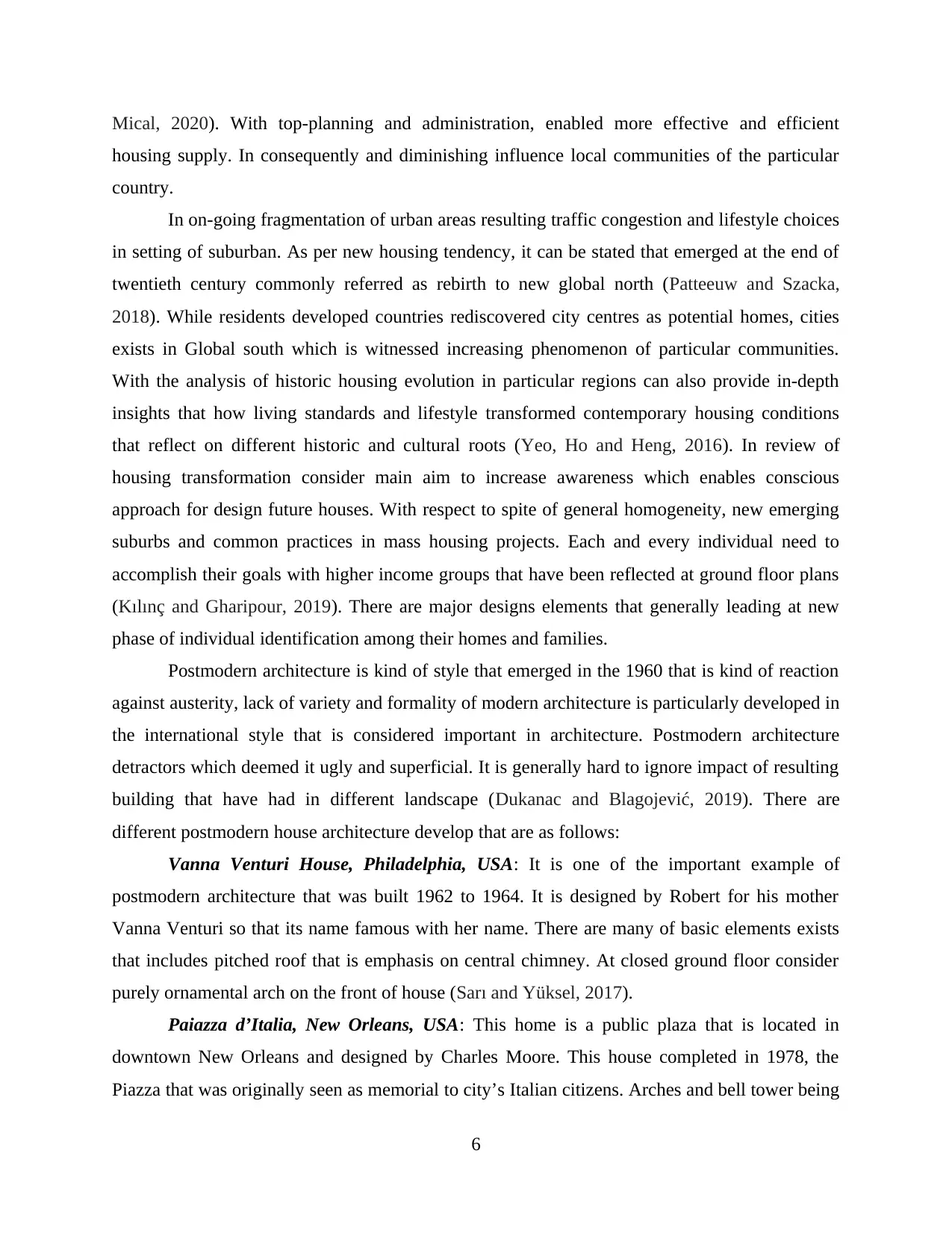
Mical, 2020). With top-planning and administration, enabled more effective and efficient
housing supply. In consequently and diminishing influence local communities of the particular
country.
In on-going fragmentation of urban areas resulting traffic congestion and lifestyle choices
in setting of suburban. As per new housing tendency, it can be stated that emerged at the end of
twentieth century commonly referred as rebirth to new global north (Patteeuw and Szacka,
2018). While residents developed countries rediscovered city centres as potential homes, cities
exists in Global south which is witnessed increasing phenomenon of particular communities.
With the analysis of historic housing evolution in particular regions can also provide in-depth
insights that how living standards and lifestyle transformed contemporary housing conditions
that reflect on different historic and cultural roots (Yeo, Ho and Heng, 2016). In review of
housing transformation consider main aim to increase awareness which enables conscious
approach for design future houses. With respect to spite of general homogeneity, new emerging
suburbs and common practices in mass housing projects. Each and every individual need to
accomplish their goals with higher income groups that have been reflected at ground floor plans
(Kılınç and Gharipour, 2019). There are major designs elements that generally leading at new
phase of individual identification among their homes and families.
Postmodern architecture is kind of style that emerged in the 1960 that is kind of reaction
against austerity, lack of variety and formality of modern architecture is particularly developed in
the international style that is considered important in architecture. Postmodern architecture
detractors which deemed it ugly and superficial. It is generally hard to ignore impact of resulting
building that have had in different landscape (Dukanac and Blagojević, 2019). There are
different postmodern house architecture develop that are as follows:
Vanna Venturi House, Philadelphia, USA: It is one of the important example of
postmodern architecture that was built 1962 to 1964. It is designed by Robert for his mother
Vanna Venturi so that its name famous with her name. There are many of basic elements exists
that includes pitched roof that is emphasis on central chimney. At closed ground floor consider
purely ornamental arch on the front of house (Sarı and Yüksel, 2017).
Paiazza d’Italia, New Orleans, USA: This home is a public plaza that is located in
downtown New Orleans and designed by Charles Moore. This house completed in 1978, the
Piazza that was originally seen as memorial to city’s Italian citizens. Arches and bell tower being
6
housing supply. In consequently and diminishing influence local communities of the particular
country.
In on-going fragmentation of urban areas resulting traffic congestion and lifestyle choices
in setting of suburban. As per new housing tendency, it can be stated that emerged at the end of
twentieth century commonly referred as rebirth to new global north (Patteeuw and Szacka,
2018). While residents developed countries rediscovered city centres as potential homes, cities
exists in Global south which is witnessed increasing phenomenon of particular communities.
With the analysis of historic housing evolution in particular regions can also provide in-depth
insights that how living standards and lifestyle transformed contemporary housing conditions
that reflect on different historic and cultural roots (Yeo, Ho and Heng, 2016). In review of
housing transformation consider main aim to increase awareness which enables conscious
approach for design future houses. With respect to spite of general homogeneity, new emerging
suburbs and common practices in mass housing projects. Each and every individual need to
accomplish their goals with higher income groups that have been reflected at ground floor plans
(Kılınç and Gharipour, 2019). There are major designs elements that generally leading at new
phase of individual identification among their homes and families.
Postmodern architecture is kind of style that emerged in the 1960 that is kind of reaction
against austerity, lack of variety and formality of modern architecture is particularly developed in
the international style that is considered important in architecture. Postmodern architecture
detractors which deemed it ugly and superficial. It is generally hard to ignore impact of resulting
building that have had in different landscape (Dukanac and Blagojević, 2019). There are
different postmodern house architecture develop that are as follows:
Vanna Venturi House, Philadelphia, USA: It is one of the important example of
postmodern architecture that was built 1962 to 1964. It is designed by Robert for his mother
Vanna Venturi so that its name famous with her name. There are many of basic elements exists
that includes pitched roof that is emphasis on central chimney. At closed ground floor consider
purely ornamental arch on the front of house (Sarı and Yüksel, 2017).
Paiazza d’Italia, New Orleans, USA: This home is a public plaza that is located in
downtown New Orleans and designed by Charles Moore. This house completed in 1978, the
Piazza that was originally seen as memorial to city’s Italian citizens. Arches and bell tower being
6
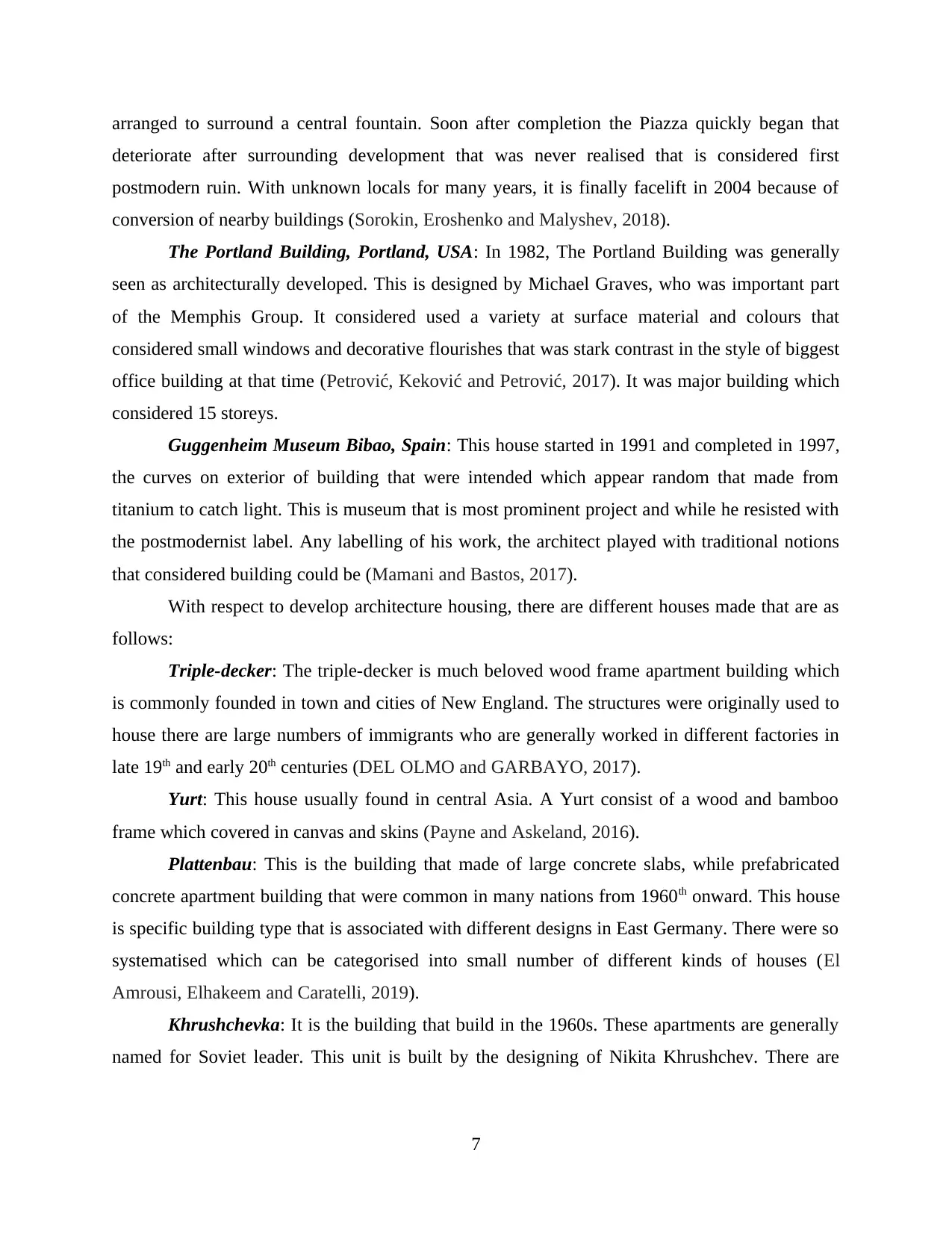
arranged to surround a central fountain. Soon after completion the Piazza quickly began that
deteriorate after surrounding development that was never realised that is considered first
postmodern ruin. With unknown locals for many years, it is finally facelift in 2004 because of
conversion of nearby buildings (Sorokin, Eroshenko and Malyshev, 2018).
The Portland Building, Portland, USA: In 1982, The Portland Building was generally
seen as architecturally developed. This is designed by Michael Graves, who was important part
of the Memphis Group. It considered used a variety at surface material and colours that
considered small windows and decorative flourishes that was stark contrast in the style of biggest
office building at that time (Petrović, Keković and Petrović, 2017). It was major building which
considered 15 storeys.
Guggenheim Museum Bibao, Spain: This house started in 1991 and completed in 1997,
the curves on exterior of building that were intended which appear random that made from
titanium to catch light. This is museum that is most prominent project and while he resisted with
the postmodernist label. Any labelling of his work, the architect played with traditional notions
that considered building could be (Mamani and Bastos, 2017).
With respect to develop architecture housing, there are different houses made that are as
follows:
Triple-decker: The triple-decker is much beloved wood frame apartment building which
is commonly founded in town and cities of New England. The structures were originally used to
house there are large numbers of immigrants who are generally worked in different factories in
late 19th and early 20th centuries (DEL OLMO and GARBAYO, 2017).
Yurt: This house usually found in central Asia. A Yurt consist of a wood and bamboo
frame which covered in canvas and skins (Payne and Askeland, 2016).
Plattenbau: This is the building that made of large concrete slabs, while prefabricated
concrete apartment building that were common in many nations from 1960th onward. This house
is specific building type that is associated with different designs in East Germany. There were so
systematised which can be categorised into small number of different kinds of houses (El
Amrousi, Elhakeem and Caratelli, 2019).
Khrushchevka: It is the building that build in the 1960s. These apartments are generally
named for Soviet leader. This unit is built by the designing of Nikita Khrushchev. There are
7
deteriorate after surrounding development that was never realised that is considered first
postmodern ruin. With unknown locals for many years, it is finally facelift in 2004 because of
conversion of nearby buildings (Sorokin, Eroshenko and Malyshev, 2018).
The Portland Building, Portland, USA: In 1982, The Portland Building was generally
seen as architecturally developed. This is designed by Michael Graves, who was important part
of the Memphis Group. It considered used a variety at surface material and colours that
considered small windows and decorative flourishes that was stark contrast in the style of biggest
office building at that time (Petrović, Keković and Petrović, 2017). It was major building which
considered 15 storeys.
Guggenheim Museum Bibao, Spain: This house started in 1991 and completed in 1997,
the curves on exterior of building that were intended which appear random that made from
titanium to catch light. This is museum that is most prominent project and while he resisted with
the postmodernist label. Any labelling of his work, the architect played with traditional notions
that considered building could be (Mamani and Bastos, 2017).
With respect to develop architecture housing, there are different houses made that are as
follows:
Triple-decker: The triple-decker is much beloved wood frame apartment building which
is commonly founded in town and cities of New England. The structures were originally used to
house there are large numbers of immigrants who are generally worked in different factories in
late 19th and early 20th centuries (DEL OLMO and GARBAYO, 2017).
Yurt: This house usually found in central Asia. A Yurt consist of a wood and bamboo
frame which covered in canvas and skins (Payne and Askeland, 2016).
Plattenbau: This is the building that made of large concrete slabs, while prefabricated
concrete apartment building that were common in many nations from 1960th onward. This house
is specific building type that is associated with different designs in East Germany. There were so
systematised which can be categorised into small number of different kinds of houses (El
Amrousi, Elhakeem and Caratelli, 2019).
Khrushchevka: It is the building that build in the 1960s. These apartments are generally
named for Soviet leader. This unit is built by the designing of Nikita Khrushchev. There are
7
⊘ This is a preview!⊘
Do you want full access?
Subscribe today to unlock all pages.

Trusted by 1+ million students worldwide
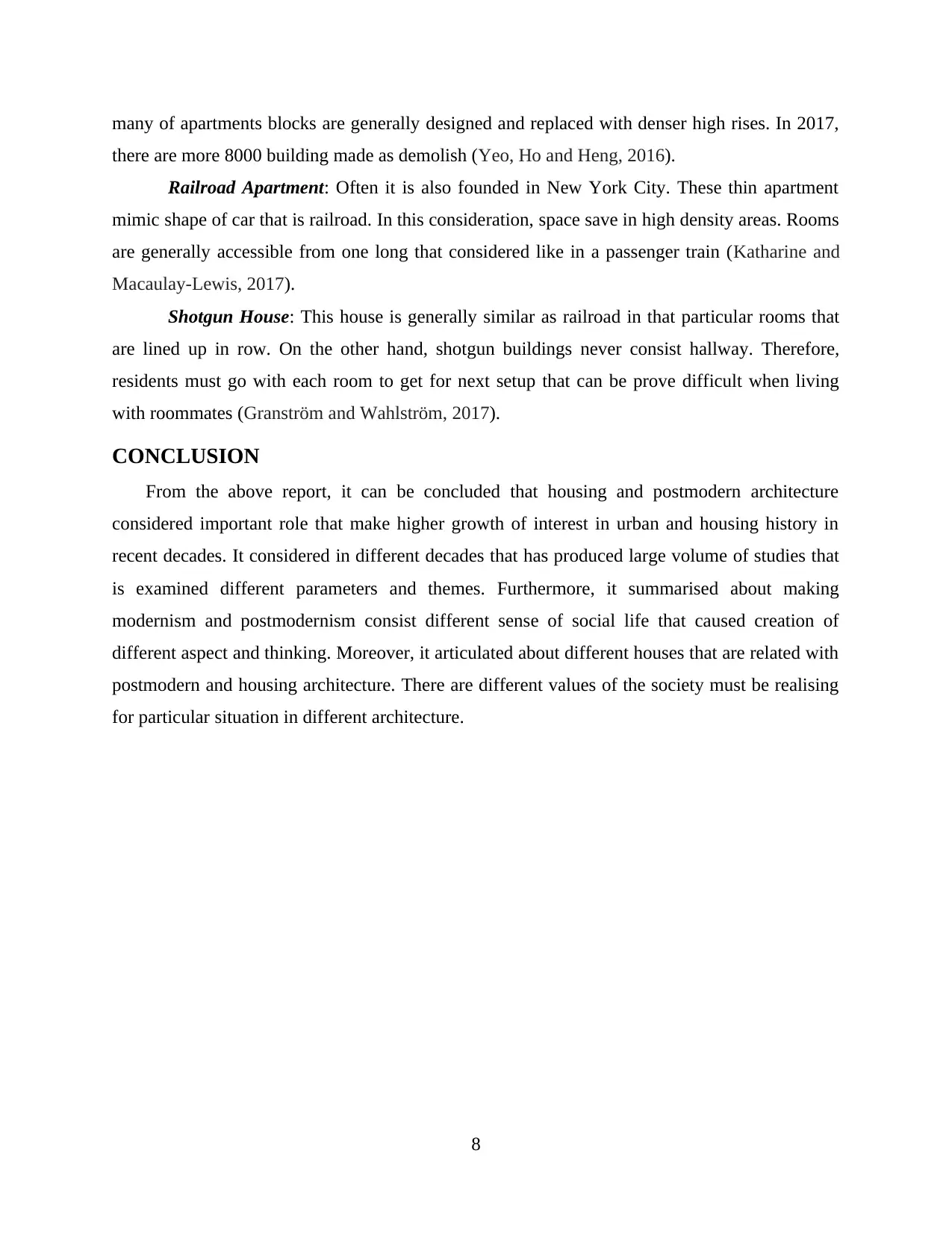
many of apartments blocks are generally designed and replaced with denser high rises. In 2017,
there are more 8000 building made as demolish (Yeo, Ho and Heng, 2016).
Railroad Apartment: Often it is also founded in New York City. These thin apartment
mimic shape of car that is railroad. In this consideration, space save in high density areas. Rooms
are generally accessible from one long that considered like in a passenger train (Katharine and
Macaulay-Lewis, 2017).
Shotgun House: This house is generally similar as railroad in that particular rooms that
are lined up in row. On the other hand, shotgun buildings never consist hallway. Therefore,
residents must go with each room to get for next setup that can be prove difficult when living
with roommates (Granström and Wahlström, 2017).
CONCLUSION
From the above report, it can be concluded that housing and postmodern architecture
considered important role that make higher growth of interest in urban and housing history in
recent decades. It considered in different decades that has produced large volume of studies that
is examined different parameters and themes. Furthermore, it summarised about making
modernism and postmodernism consist different sense of social life that caused creation of
different aspect and thinking. Moreover, it articulated about different houses that are related with
postmodern and housing architecture. There are different values of the society must be realising
for particular situation in different architecture.
8
there are more 8000 building made as demolish (Yeo, Ho and Heng, 2016).
Railroad Apartment: Often it is also founded in New York City. These thin apartment
mimic shape of car that is railroad. In this consideration, space save in high density areas. Rooms
are generally accessible from one long that considered like in a passenger train (Katharine and
Macaulay-Lewis, 2017).
Shotgun House: This house is generally similar as railroad in that particular rooms that
are lined up in row. On the other hand, shotgun buildings never consist hallway. Therefore,
residents must go with each room to get for next setup that can be prove difficult when living
with roommates (Granström and Wahlström, 2017).
CONCLUSION
From the above report, it can be concluded that housing and postmodern architecture
considered important role that make higher growth of interest in urban and housing history in
recent decades. It considered in different decades that has produced large volume of studies that
is examined different parameters and themes. Furthermore, it summarised about making
modernism and postmodernism consist different sense of social life that caused creation of
different aspect and thinking. Moreover, it articulated about different houses that are related with
postmodern and housing architecture. There are different values of the society must be realising
for particular situation in different architecture.
8
Paraphrase This Document
Need a fresh take? Get an instant paraphrase of this document with our AI Paraphraser
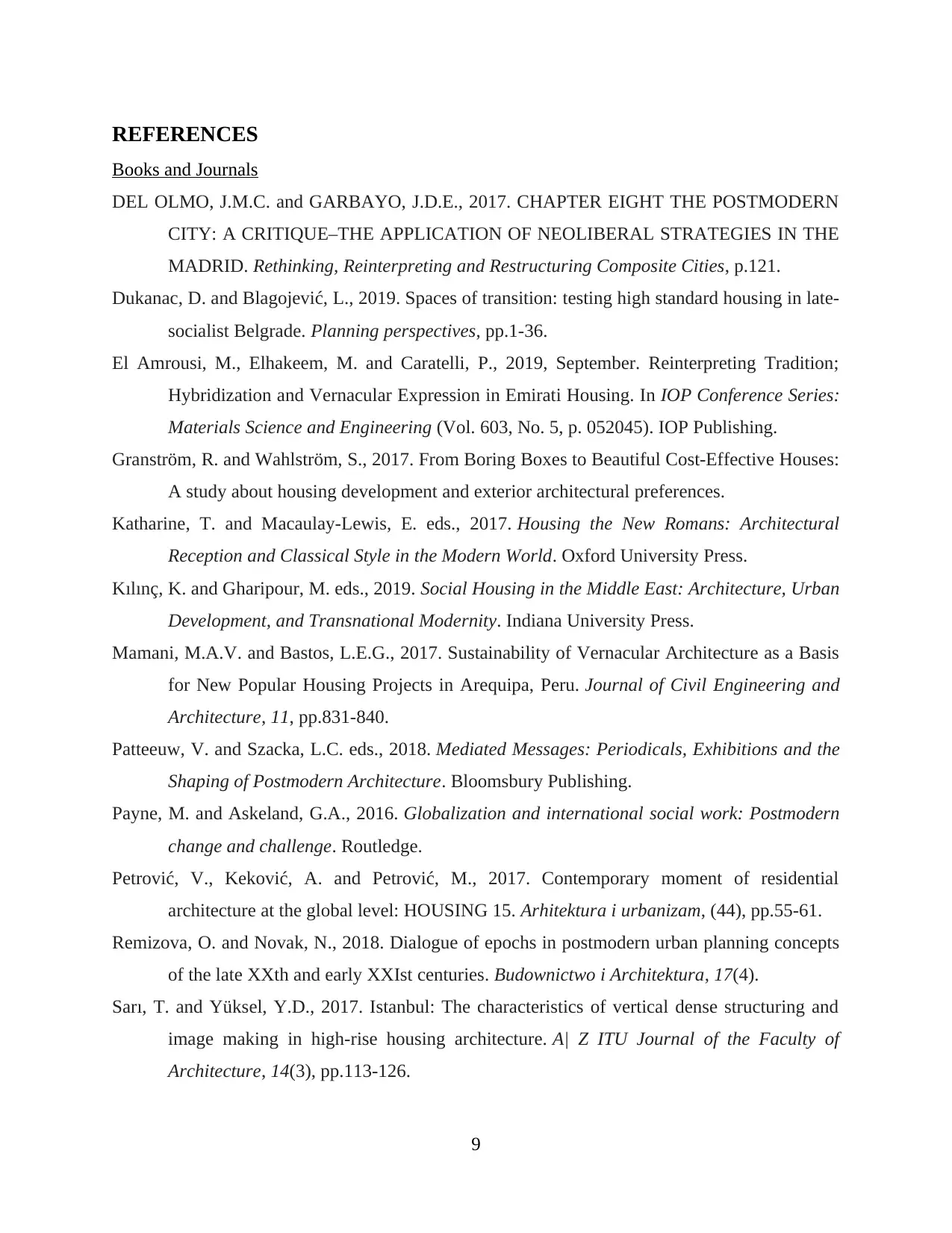
REFERENCES
Books and Journals
DEL OLMO, J.M.C. and GARBAYO, J.D.E., 2017. CHAPTER EIGHT THE POSTMODERN
CITY: A CRITIQUE–THE APPLICATION OF NEOLIBERAL STRATEGIES IN THE
MADRID. Rethinking, Reinterpreting and Restructuring Composite Cities, p.121.
Dukanac, D. and Blagojević, L., 2019. Spaces of transition: testing high standard housing in late-
socialist Belgrade. Planning perspectives, pp.1-36.
El Amrousi, M., Elhakeem, M. and Caratelli, P., 2019, September. Reinterpreting Tradition;
Hybridization and Vernacular Expression in Emirati Housing. In IOP Conference Series:
Materials Science and Engineering (Vol. 603, No. 5, p. 052045). IOP Publishing.
Granström, R. and Wahlström, S., 2017. From Boring Boxes to Beautiful Cost-Effective Houses:
A study about housing development and exterior architectural preferences.
Katharine, T. and Macaulay-Lewis, E. eds., 2017. Housing the New Romans: Architectural
Reception and Classical Style in the Modern World. Oxford University Press.
Kılınç, K. and Gharipour, M. eds., 2019. Social Housing in the Middle East: Architecture, Urban
Development, and Transnational Modernity. Indiana University Press.
Mamani, M.A.V. and Bastos, L.E.G., 2017. Sustainability of Vernacular Architecture as a Basis
for New Popular Housing Projects in Arequipa, Peru. Journal of Civil Engineering and
Architecture, 11, pp.831-840.
Patteeuw, V. and Szacka, L.C. eds., 2018. Mediated Messages: Periodicals, Exhibitions and the
Shaping of Postmodern Architecture. Bloomsbury Publishing.
Payne, M. and Askeland, G.A., 2016. Globalization and international social work: Postmodern
change and challenge. Routledge.
Petrović, V., Keković, A. and Petrović, M., 2017. Contemporary moment of residential
architecture at the global level: HOUSING 15. Arhitektura i urbanizam, (44), pp.55-61.
Remizova, O. and Novak, N., 2018. Dialogue of epochs in postmodern urban planning concepts
of the late ХХth and early ХХIst centuries. Budownictwo i Architektura, 17(4).
Sarı, T. and Yüksel, Y.D., 2017. Istanbul: The characteristics of vertical dense structuring and
image making in high-rise housing architecture. A| Z ITU Journal of the Faculty of
Architecture, 14(3), pp.113-126.
9
Books and Journals
DEL OLMO, J.M.C. and GARBAYO, J.D.E., 2017. CHAPTER EIGHT THE POSTMODERN
CITY: A CRITIQUE–THE APPLICATION OF NEOLIBERAL STRATEGIES IN THE
MADRID. Rethinking, Reinterpreting and Restructuring Composite Cities, p.121.
Dukanac, D. and Blagojević, L., 2019. Spaces of transition: testing high standard housing in late-
socialist Belgrade. Planning perspectives, pp.1-36.
El Amrousi, M., Elhakeem, M. and Caratelli, P., 2019, September. Reinterpreting Tradition;
Hybridization and Vernacular Expression in Emirati Housing. In IOP Conference Series:
Materials Science and Engineering (Vol. 603, No. 5, p. 052045). IOP Publishing.
Granström, R. and Wahlström, S., 2017. From Boring Boxes to Beautiful Cost-Effective Houses:
A study about housing development and exterior architectural preferences.
Katharine, T. and Macaulay-Lewis, E. eds., 2017. Housing the New Romans: Architectural
Reception and Classical Style in the Modern World. Oxford University Press.
Kılınç, K. and Gharipour, M. eds., 2019. Social Housing in the Middle East: Architecture, Urban
Development, and Transnational Modernity. Indiana University Press.
Mamani, M.A.V. and Bastos, L.E.G., 2017. Sustainability of Vernacular Architecture as a Basis
for New Popular Housing Projects in Arequipa, Peru. Journal of Civil Engineering and
Architecture, 11, pp.831-840.
Patteeuw, V. and Szacka, L.C. eds., 2018. Mediated Messages: Periodicals, Exhibitions and the
Shaping of Postmodern Architecture. Bloomsbury Publishing.
Payne, M. and Askeland, G.A., 2016. Globalization and international social work: Postmodern
change and challenge. Routledge.
Petrović, V., Keković, A. and Petrović, M., 2017. Contemporary moment of residential
architecture at the global level: HOUSING 15. Arhitektura i urbanizam, (44), pp.55-61.
Remizova, O. and Novak, N., 2018. Dialogue of epochs in postmodern urban planning concepts
of the late ХХth and early ХХIst centuries. Budownictwo i Architektura, 17(4).
Sarı, T. and Yüksel, Y.D., 2017. Istanbul: The characteristics of vertical dense structuring and
image making in high-rise housing architecture. A| Z ITU Journal of the Faculty of
Architecture, 14(3), pp.113-126.
9
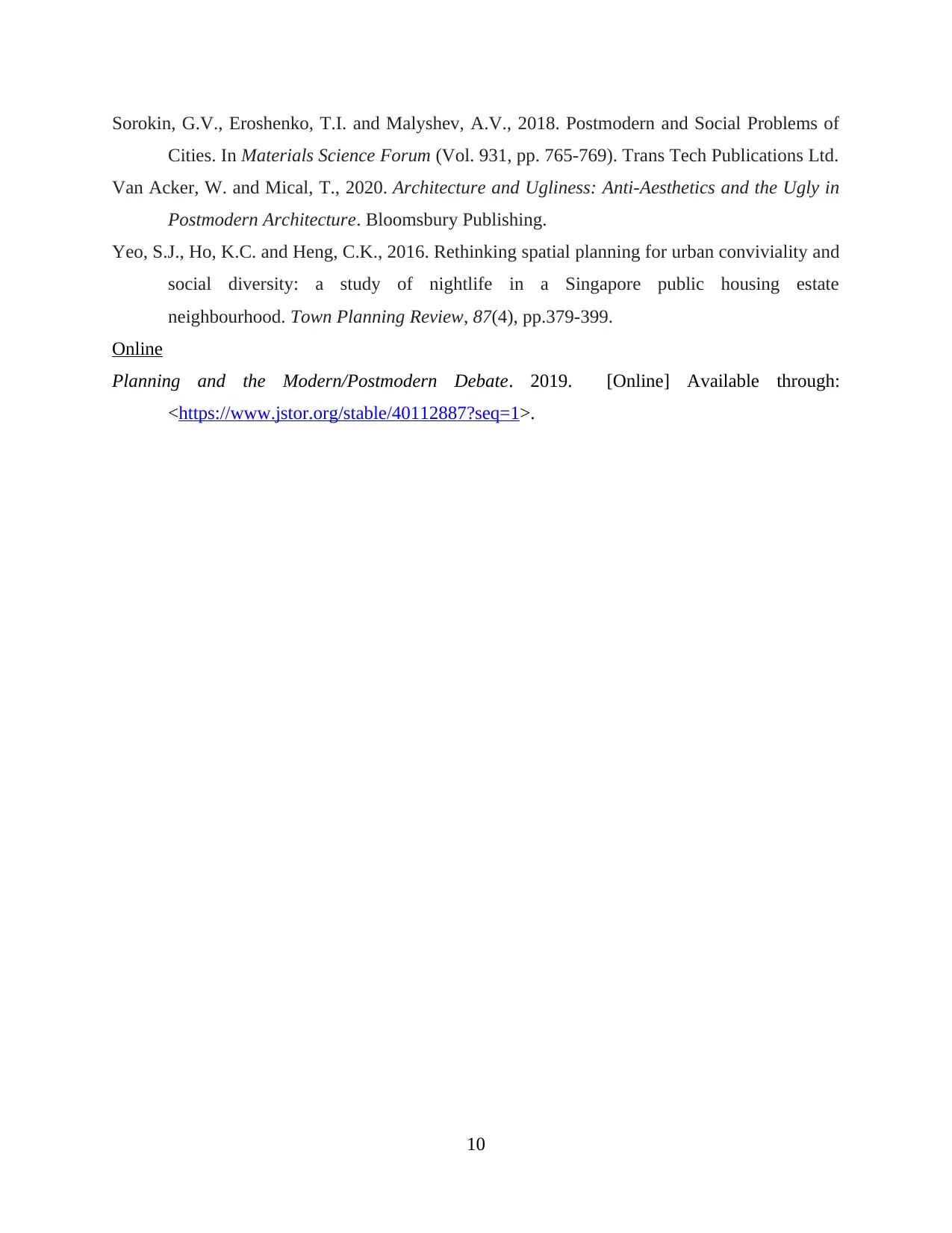
Sorokin, G.V., Eroshenko, T.I. and Malyshev, A.V., 2018. Postmodern and Social Problems of
Cities. In Materials Science Forum (Vol. 931, pp. 765-769). Trans Tech Publications Ltd.
Van Acker, W. and Mical, T., 2020. Architecture and Ugliness: Anti-Aesthetics and the Ugly in
Postmodern Architecture. Bloomsbury Publishing.
Yeo, S.J., Ho, K.C. and Heng, C.K., 2016. Rethinking spatial planning for urban conviviality and
social diversity: a study of nightlife in a Singapore public housing estate
neighbourhood. Town Planning Review, 87(4), pp.379-399.
Online
Planning and the Modern/Postmodern Debate. 2019. [Online] Available through:
<https://www.jstor.org/stable/40112887?seq=1>.
10
Cities. In Materials Science Forum (Vol. 931, pp. 765-769). Trans Tech Publications Ltd.
Van Acker, W. and Mical, T., 2020. Architecture and Ugliness: Anti-Aesthetics and the Ugly in
Postmodern Architecture. Bloomsbury Publishing.
Yeo, S.J., Ho, K.C. and Heng, C.K., 2016. Rethinking spatial planning for urban conviviality and
social diversity: a study of nightlife in a Singapore public housing estate
neighbourhood. Town Planning Review, 87(4), pp.379-399.
Online
Planning and the Modern/Postmodern Debate. 2019. [Online] Available through:
<https://www.jstor.org/stable/40112887?seq=1>.
10
⊘ This is a preview!⊘
Do you want full access?
Subscribe today to unlock all pages.

Trusted by 1+ million students worldwide
1 out of 12
Related Documents
Your All-in-One AI-Powered Toolkit for Academic Success.
+13062052269
info@desklib.com
Available 24*7 on WhatsApp / Email
![[object Object]](/_next/static/media/star-bottom.7253800d.svg)
Unlock your academic potential
Copyright © 2020–2025 A2Z Services. All Rights Reserved. Developed and managed by ZUCOL.



